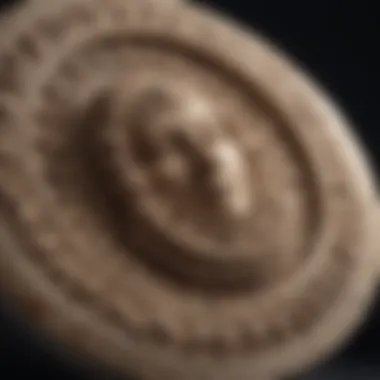Unveiling the Enigmatic World of Indian Mountain Whetstones


Rock and Fossil Identification
Indian mountain whetstones, with their geological origin in the majestic Indian mountains, are a subject of intrigue for enthusiasts and collectors. These unique geological specimens boast a range of characteristics that distinguish them from other rocks and fossils commonly found in the region. Their distinct properties make them a favored choice among artisans and craftsmen for their unparalleled sharpening abilities. Identifying these mountain whetstones entails examining their color variations, texture, and density. Tools such as magnifying lenses and hardness scales are essential for a thorough assessment.
Collecting Tips and Techniques
When embarking on a quest to collect Indian mountain whetstones, adhering to best practices is crucial for a fruitful expedition. Experienced collectors emphasize the importance of researching prime collecting sites in the craggy terrains of the Indian mountains, where these prized specimens are abundant. To safely extract these specimens without causing damage, specialized tools like chisels and brushes come in handy. Patience and precision are key during the extraction process, ensuring that the whetstones are obtained intact.
Preservation and Display
Preservation techniques play a vital role in maintaining the integrity of Indian mountain whetstones post-collection. Proper cleaning methods should be applied to rid the specimens of any debris without altering their natural form. Storing these whetstones in a cool, dry environment helps prevent degradation over time. For enthusiasts keen on displaying their collection, creative ideas like custom shadow boxes or secured shelving arrangements can enhance the aesthetic appeal while safeguarding the specimens from external factors.
Geological Insights
Delving into the geological insights of Indian mountain whetstones unveils a rich tapestry of information regarding their formation and historical significance. These natural formations bear testimony to the tectonic forces that shaped the Indian subcontinent over millions of years, offering a glimpse into ancient geological processes. The historical relevance of these whetstones stems from their traditional role in Indian craftsmanship, where they were utilized for honing blades and sculpting intricate designs. Notable discoveries in the field continue to shed light on the diverse applications of these whetstones, propelling further research and appreciation for their geological value.
Introduction
In the vast expanse of geological wonders, Indian mountain whetstones stand out as intriguing specimens that have captivated the interest of enthusiasts and researchers alike. These unique stones, with their historical significance and practical applications, offer a window into a bygone era where craftsmanship and artistry were intertwined with utilitarian functions. This article embarks on a journey to unravel the mysteries and complexities surrounding Indian mountain whetstones, shedding light on their geological origins, cultural importance, and contemporary relevance.
What Are Indian Mountain Whetstones?
Indian mountain whetstones, also known as sharpening stones or oilstones, are natural geological formations found in mountainous regions of India. These stones possess unique properties that make them ideal for sharpening blades, tools, and other cutting implements. Known for their fine grit and abrasive surfaces, Indian mountain whetstones have been sought after for centuries for their superior sharpening capabilities. They come in a variety of colors and textures, each indicative of their specific mineral composition and geological formation.
Significance of Indian Mountain Whetstones
The significance of Indian mountain whetstones lies in their historical role as essential tools for indigenous communities and craftsmen. These stones not only served practical purposes but also held symbolic and ritualistic importance in various cultures. Their presence in trade and commerce routes highlights their value as commodities that were highly prized for their quality and effectiveness. Additionally, Indian mountain whetstones have been integrated into mythological narratives and religious practices, adding layers of symbolism to their already multifaceted nature.


Purpose of the Article
This article aims to provide a comprehensive exploration of Indian mountain whetstones, from their geological formation to their contemporary applications. By delving into their historical significance, practical uses, and cultural implications, this piece seeks to offer readers a nuanced understanding of these fascinating geological specimens. Through detailed analysis and insights, the article endeavours to showcase the enduring relevance and importance of Indian mountain whetstones in various spheres, including craftsmanship, archaeology, and industry.
Geological Origins
As we embark on our journey to unravel the enigmatic world of Indian mountain whetstones, it is imperative to first grasp the essential foundation - their geological origins. Understanding the genesis of these fascinating specimens provides us with profound insights into their formation processes, composition, and intrinsic qualities. By delving into the geological origins of Indian mountain whetstones, we can decipher the intricate tapestry of nature's artistry and unravel the mysteries that lie beneath the surface of these unique formations.
Formation of Indian Mountain Whetstones
The formation of Indian mountain whetstones is a complex interplay of geological processes spanning thousands of years. From the accumulation of sedimentary layers to the transformative forces of pressure and heat, these whetstones undergo a remarkable journey to attain their distinct characteristics. By exploring the formation mechanisms in detail, we can appreciate the geological forces at play and comprehend the rarity and significance of these natural wonders.
Distinctive Characteristics
Porosity
Porosity, a defining trait of Indian mountain whetstones, plays a pivotal role in both their structural integrity and functional efficacy. The porous nature of these stones enables efficient absorption of water or oil, crucial for the sharpening and polishing of various tools and blades. Its unique porosity not only enhances the sharpening process but also prolongs the lifespan of the whetstone, making it a preferred choice for craftsmen and artisans seeking precision and durability in their work.
Color Variations
The diverse range of color variations exhibited by Indian mountain whetstones adds an element of charm and individuality to each specimen. Ranging from earthy browns to mesmerizing swirls of grey and white, these color variations are a testament to the diverse mineral compositions embedded within these stones. The hues not only reflect the geological diversity of their origins but also offer collectors and enthusiasts a visual feast of nature's artistic palette.
Texture
The texture of Indian mountain whetstones is a tactile delight, renowned for its smoothness and consistency. This characteristic texture, honed over millennia of geological processes, ensures a seamless sharpening and polishing experience for users. Whether refining a blade or sculpting a work of art, the uniform texture of these whetstones provides a perfect canvas for craftsmen to showcase their skills and precision.
Geographical Distribution
The geographical distribution of Indian mountain whetstones spans across diverse terrains, from the rugged slopes of the Western Ghats to the serene valleys of the Himalayas. Each region offers a unique blend of geological conditions and mineral deposits, shaping the characteristics and properties of the whetstones found within. By exploring the geographical distribution in depth, we can map out the rich tapestry of locations that harbor these geological treasures, unraveling the intricate connections between geography, geology, and cultural heritage.


Historical Significance
Indian mountain whetstones hold a deep historical significance that transcends mere geological curiosity. These unique specimens have been integral to the lives of indigenous communities for centuries, serving as indispensable tools for sharpening blades, tools, and implements essential for their daily tasks. The utilization of Indian mountain whetstones by these communities signifies a deep connection to their land and a rich tradition of craftsmanship passed down through generations. The reliance on these whetstones highlights the resourcefulness and ingenuity of indigenous cultures in enhancing the durability and efficacy of their tools. Moreover, the historical significance of Indian mountain whetstones extends beyond practical applications, encompassing spiritual, cultural, and social dimensions that offer a profound insight into the beliefs and practices of the communities that have cherished these stones throughout history.
Utilization by Indigenous Communities
The utilization of Indian mountain whetstones by indigenous communities goes beyond mere functional necessity; it is a testament to their intrinsic connection to the land and their cultural heritage. These communities have developed intricate techniques for harnessing the sharpening properties of the whetstones, ensuring the longevity and sharpness of their tools. The process of using these whetstones is often imbued with rituals and ceremonies that symbolize respect for the natural environment and the ancestral knowledge embedded in the act of sharpening. Through the utilization of Indian mountain whetstones, indigenous communities not only maintain their tools but also preserve a centuries-old tradition that reflects their deep spiritual and practical relationship with the land.
Trade and Commerce
The trade and commerce surrounding Indian mountain whetstones have played a pivotal role in shaping cultural exchanges and economic activities in various regions. These unique geological resources have been valued commodities in ancient trade networks, facilitating the exchange of goods and technologies between different communities. The commercial significance of Indian mountain whetstones extends to the present day, with collectors, artisans, and traders appreciating their distinctive properties for both practical and aesthetic purposes. The economic value of these whetstones lies not only in their utility but also in the stories they carry – tales of craftsmanship, heritage, and regional identity that add a layer of cultural richness to the trade dynamics. By delving into the trade and commerce of Indian mountain whetstones, one can unravel a tapestry of human interactions, innovation, and historical contingent that have shaped the market for these remarkable geological specimens.
Mythological and Ritualistic Uses
In addition to their practical applications, Indian mountain whetstones hold a significant place in the realm of myth and ritual. Across diverse cultures and traditions, these whetstones are often imbued with symbolic meanings and spiritual connotations that transcend their physical properties. Mythological narratives associate these stones with deities, spirits, and cosmic forces, attributing them with mystical powers and protective qualities. The ritualistic uses of Indian mountain whetstones involve ceremonies, offerings, and practices aimed at honoring the inherent energies believed to reside within the stones. By exploring the mythological and ritualistic dimensions of these whetstones, one unravels a tapestry of beliefs, superstitions, and cultural practices that illuminate the profound impact of these geological wonders on human imagination and spiritual life.
Practical Applications
In this section, we will delve into the practical applications of Indian mountain whetstones, shedding light on their crucial role in various industries and art forms. These whetstones are not merely geological artifacts but serve as essential tools for sharpening, polishing, and enhancing the functionality of blades and tools. Their unique texture and porosity make them ideal for precision sharpening, ensuring the longevity and efficiency of cutting implements. Moreover, the cultural and artistic significance of these whetstones cannot be overlooked, as they play a vital role in traditional craftsmanship and sculpture. Understanding the practical applications of Indian mountain whetstones is key to appreciating their value beyond their geological origins.
Sharpening Tools and Blades
Sharpening tools and blades using Indian mountain whetstones is an art that has been perfected over centuries. The whetstones' porous surface allows for meticulous sharpening, creating razor-sharp edges that are crucial for various cutting tasks. Blades crafted using these whetstones exhibit exceptional sharpness and durability, making them indispensable in professions like blacksmithing and woodworking. The intricate process of sharpening tools and blades with Indian mountain whetstones showcases the precision and expertise required to harness the full potential of these geological wonders.
Polishing and Finishing Techniques
Indian mountain whetstones are not limited to sharpening tools; they also excel in polishing and finishing various materials. The fine texture and uniformity of these whetstones enable craftsmen to achieve immaculate finishes on metalwork, sculptures, and other artistic creations. By employing specific polishing techniques with Indian mountain whetstones, artisans can bring out the natural luster and beauty of the materials they work with. The use of these whetstones in finishing techniques highlights their versatile nature and their indispensable role in enhancing the aesthetic appeal of finished products.


Cultural and Artistic Purposes
Beyond their utilitarian functions, Indian mountain whetstones hold immense cultural and artistic significance. In traditional Indian art forms, these whetstones are revered for their role in shaping intricate designs and patterns on decorative items. Artisans incorporate the unique properties of Indian mountain whetstones into their creative processes, adding a touch of authenticity and heritage to their work. The cultural heritage preserved in the use of these whetstones for artistic purposes underscores the deep-seated connection between geology, culture, and art in Indian traditions.
Preservation and Conservation
In the realm of Indian mountain whetstones, the aspect of preservation and conservation holds paramount importance. These geological specimens, with their unique properties and historical significance, require meticulous care to ensure their longevity and continued availability for study and admiration. Preservation and conservation efforts play a crucial role in safeguarding these treasures for future generations to appreciate and explore. By delving into the preservation and conservation practices surrounding Indian mountain whetstones, we gain a deeper understanding of their value and significance.
Challenges in Conservation
Navigating the challenges of conservation in the context of Indian mountain whetstones is a complex task. One significant challenge lies in the delicate balance between conservation and accessibility. While it is vital to protect these specimens from environmental degradation and human interference, it is also essential to make them accessible for research, education, and public engagement. Furthermore, factors such as geological processes, climate change, and human activities pose ongoing challenges to the preservation of Indian mountain whetstones. Addressing these challenges requires a multi-faceted approach that accounts for both natural and anthropogenic factors.
Best Practices for Preservation
Implementing best practices for the preservation of Indian mountain whetstones is crucial for maintaining their integrity and research value. Storage under controlled environmental conditions, proper handling techniques, and regular monitoring are fundamental practices in conserving these geological wonders. Additionally, engaging in interdisciplinary collaborations and research initiatives can enhance our understanding of preservation techniques tailored to the unique properties of Indian mountain whetstones. By adhering to best practices in preservation, we can ensure the longevity and accessibility of these valuable specimens for scientific study and cultural appreciation.
Role of Collectors and Institutions
Collectors and institutions play a pivotal role in the preservation and conservation of Indian mountain whetstones. Collectors often serve as custodians of rare specimens, safeguarding them from illicit trade and environmental hazards. Their expertise in identifying, documenting, and sharing information about these geological treasures contributes to the broader understanding and appreciation of Indian mountain whetstones. Furthermore, institutions such as museums, research centers, and educational organizations provide essential infrastructure and resources for the conservation and study of these specimens. Collaborative efforts between collectors, institutions, and conservation experts are essential in ensuring the sustainable preservation of Indian mountain whetstones for future generations.
Current Research and Future Prospects
In the realm of Indian mountain whetstones, delving into current research and future prospects unveils a landscape ripe with possibilities. Scientists and experts are increasingly intrigued by these geological specimens, propelling them into the spotlight of innovative studies and technological advancements. The importance of current research lies in unraveling hidden mysteries and untapped potential locked within these ancient stones.
Technological Advancements
Technological advancements in the field of Indian mountain whetstones have ushered in a new era of precision and efficiency. Cutting-edge tools and techniques allow researchers to analyze these stones at microscopic levels, uncovering intricate details that were previously inaccessible. From advanced imaging technologies to specialized testing methodologies, the marriage of science and technology sheds light on the structural composition and nuanced properties of these whetstones.
Cross-disciplinary Studies
Cross-disciplinary studies play a pivotal role in expanding our understanding of Indian mountain whetstones beyond geological boundaries. By integrating knowledge and methodologies from diverse fields such as archaeology, geology, chemistry, and cultural studies, researchers can paint a holistic picture of the impact and significance of these stones throughout history. The interdisciplinary approach offers fresh perspectives and opens doors to new avenues of exploration, enriching the narrative surrounding Indian mountain whetstones.
Innovative Applications in Modern Industries
The innovative applications of Indian mountain whetstones in modern industries herald a wave of adaptive uses and functional evolution. From eco-friendly construction materials to high-precision cutting tools, these stones bridge the gap between tradition and contemporary innovation. Integrating the durability and unique characteristics of whetstones into varied industrial sectors promises efficiency, sustainability, and a touch of antiquity in the technology-driven world we inhabit.







